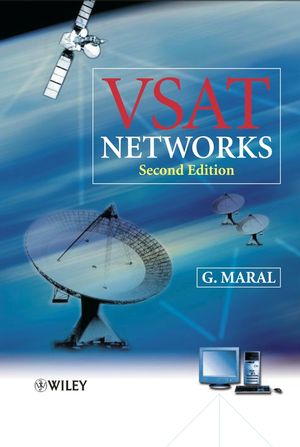VSAT Networks, 2nd EditionISBN: 978-0-470-86684-9
Hardcover
304 pages
January 2004
 This is a Print-on-Demand title. It will be printed specifically to fill your order. Please allow an additional 10-15 days delivery time. The book is not returnable.
|
||||||
Preface ix
Acronyms and Abbreviations xiii
Notation xvii
1 Introduction 1
1.1 VSAT network definition 1
1.2 VSAT network configurations 5
1.3 User terminal connectivity 9
1.4 VSAT network applications and types of traffic 11
1.4.1 Civilian VSAT networks 11
1.4.2 Military VSAT networks 15
1.5 VSAT networks: involved parties 15
1.6 VSAT network options 17
1.6.1 Star or mesh? 17
1.6.2 Data/voice/video 21
1.6.3 Fixed/demand assignment 22
1.6.4 Frequency bands 24
1.6.5 Hub options 29
1.7 VSAT network earth stations 30
1.7.1 VSAT station 30
1.7.2 Hub station 35
1.8 Economic aspects 39
1.9 Regulatory aspects 41
1.9.1 Licensing 42
1.9.2 Access to the space segment 43
1.9.3 Local regulations 43
1.10 Conclusions 44
1.10.1 Advantages 44
1.10.2 Drawbacks 45
2 Use of satellites for VSAT networks 47
2.1 Introduction 48
2.1.1 The relay function 48
2.1.2 Transparent and regenerative payload 50
2.1.3 Coverage 52
2.1.4 Impact of coverage on satellite relay performance 55
2.1.5 Frequency reuse 59
2.2 Orbits 60
2.2.1 Newton’s universal law of attraction 60
2.2.2 Orbital parameters 61
2.3 The geostationary satellite 65
2.3.1 Orbit parameters 65
2.3.2 Launching the satellite 65
2.3.3 Distance to the satellite 68
2.3.4 Propagation delay 69
2.3.5 Conjunction of the sun and the satellite 69
2.3.6 Orbit perturbations 70
2.3.7 Apparent satellite movement 72
2.3.8 Orbit corrections 76
2.3.9 Doppler effect 77
2.4 Satellites for VSAT services 77
3 Operational aspects 79
3.1 Installation 79
3.1.1 Hub 79
3.1.2 VSAT 79
3.1.3 Antenna pointing 81
3.2 The customer’s concerns 85
3.2.1 Interfaces to end equipment 86
3.2.2 Independence from vendor 86
3.2.3 Set-up time 86
3.2.4 Access to the service 87
3.2.5 Flexibility 87
3.2.6 Failure and disaster recovery 87
3.2.7 Blocking probability 89
3.2.8 Response time 90
3.2.9 Link quality 91
3.2.10 Availability 91
3.2.11 Maintenance 96
3.2.12 Hazards 97
3.2.13 Cost 97
4 Networking aspects 99
4.1 Network functions 99
4.2 Some definitions 100
4.2.1 Links and connections 100
4.2.2 Bit rate 101
4.2.3 Protocols 103
4.2.4 Delay 103
4.2.5 Throughput 104
4.2.6 Channel efficiency 104
4.2.7 Channel utilisation 104
4.3 Traffic characterisation 105
4.3.1 Traffic forecasts 105
4.3.2 Traffic measurements 105
4.3.3 Traffic source modelling 106
4.4 The OSI reference model for data communications 110
4.4.1 The physical layer 112
4.4.2 The data link layer 112
4.4.3 The network layer 114
4.4.4 The transport layer 115
4.4.5 The upper layers (5 to 7) 116
4.5 Application to VSAT networks 116
4.5.1 Physical and protocol configurations of a VSAT network 116
4.5.2 Protocol conversion (emulation) 116
4.5.3 Reasons for protocol conversion 118
4.6 Multiple access 127
4.6.1 Basic multiple access protocols 129
4.6.2 Meshed networks 131
4.6.3 Star-shaped networks 134
4.6.4 Fixed assignment versus demand assignment 141
4.6.5 Random time division multiple access 149
4.6.6 Delay analysis 155
4.6.7 Conclusion 161
4.7 Network design 163
4.7.1 Principles 163
4.7.2 Guidelines for preliminary dimensioning 164
4.7.3 Example 168
4.8 Conclusion 169
5 Radio frequency link analysis 171
5.1 Principles 172
5.1.1 Thermal noise 173
5.1.2 Interference noise 174
5.1.3 Intermodulation noise 174
5.1.4 Carrier power to noise power spectral density ratio 176
5.1.5 Total noise 176
5.2 Uplink analysis 179
5.2.1 Power flux density at satellite distance 180
5.2.2 Effective isotropic radiated power of the earth station 181
5.2.3 Uplink path loss 188
5.2.4 Figure of merit of satellite receiving equipment 194
5.3 Downlink analysis 195
5.3.1 Effective isotropic radiated power of the satellite 197
5.3.2 Power Flux density at earth surface 197
5.3.3 Downlink path loss 198
5.3.4 Figure of merit of earth station receiving equipment 198
5.4 Intermodulation analysis 205
5.5 Interference analysis 207
5.5.1 Expressions for carrier-to-interference ratio 207
5.5.2 Types of interference 208
5.5.3 Self-interference 209
5.5.4 External interference 219
5.5.5 Conclusion 225
5.6 Overall link performance 226
5.7 Bit error rate determination 229
5.8 Power versus bandwidth exchange 231
5.9 Example 231
Appendices 239
Appendix 1: Traffic source models 239
Appendix 2: Automatic repeat request (ARQ) protocols 242
Appendix 3: Interface protocols 245
Appendix 4: Antenna parameters 250
Appendix 5: Emitted and received power 254
Appendix 6: Carrier amplification 257
Appendix 7: VSAT products 260
References 265
Index 267



